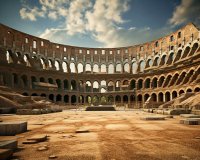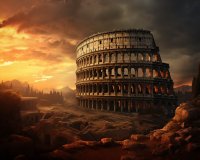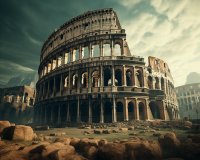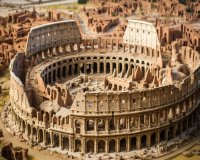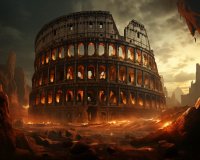Roman Forum’s Legacy Revisited

Ancient Echoes: Revisiting the Roman Forum's Legacy in Rome
The Roman Forum, nestled in the heart of Rome, is a place where history comes alive, and ancient echoes still resonate through the cobblestone streets. It stands as a testament to the glory and grandeur of the Roman Empire, a place where politics, religion, and commerce intersected, shaping the destiny of an empire. In this article, we delve into the rich history and legacy of the Roman Forum, uncovering its significance and the timeless stories it has to tell.
The Forum's Origins
The Roman Forum, or Forum Romanum in Latin, dates back to the 7th century BC. It began as a marketplace, gradually evolving into the epicenter of Roman life. The Forum's origins are intertwined with the very foundation of Rome, making it a place of unparalleled historical importance.
Architectural Marvels
As you explore the Roman Forum, you'll encounter a plethora of architectural marvels. The most iconic among them is the imposing Colosseum, an amphitheater that once hosted epic gladiatorial battles and grand spectacles. The Arch of Titus and the Arch of Septimius Severus are striking monuments that have weathered the centuries, bearing witness to countless events.
Visitors can also admire the Temple of Vesta, an ancient circular temple dedicated to the goddess of the hearth, and the Temple of Saturn, which housed the Roman Republic's treasury. Each of these structures is a testament to the architectural prowess of the ancient Romans.
Political Center
The Roman Forum served as the political heart of the Roman Empire. The Curia Julia was the Senate House, where important decisions were made, and laws were debated. It is here that some of the most influential figures in Roman history, such as Julius Caesar, Cicero, and Augustus, once walked.
Religious Significance
Religion played a pivotal role in Roman society, and the Roman Forum housed several temples. The Temple of Castor and Pollux, dedicated to the divine twins, and the Temple of Antoninus and Faustina, dedicated to the emperor's late wife, are notable examples of the Forum's religious significance.
Commercial Hub
Amidst the grandeur of politics and religion, the Roman Forum was also a bustling commercial hub. It bustled with traders, shops, and market stalls, where Romans bought and sold goods from across the empire. The Tabernae, or shops, along the Via Sacra, are a testament to the economic activities that took place in the Forum.
The Decline and Preservation
With the fall of the Western Roman Empire in the 5th century, the Forum began to decline. It was gradually buried beneath layers of silt and debris, and many of its structures were repurposed for other uses. However, in the 20th century, extensive excavations and preservation efforts were undertaken, revealing the Forum's former glory to the world.
Visiting the Roman Forum Today
Today, the Roman Forum stands as an open-air museum, offering visitors a chance to walk in the footsteps of ancient Romans. The site is a UNESCO World Heritage Site and is an essential stop for anyone interested in history, archaeology, or simply the allure of the past.
As you wander through the ruins, the whispers of the past grow louder. You can almost hear the Senate debates, the cheers of the Colosseum crowd, and the daily hustle and bustle of ancient Roman life.
So, when you find yourself in Rome, don't forget to step back in time and explore the Roman Forum. It's a place where ancient echoes reverberate, where history lives and breathes, and where the legacy of an empire endures.
Conclusion
The Roman Forum's legacy is a living testament to the grandeur and significance of the Roman Empire. As you explore this historical site, you'll discover a multifaceted past that encompasses politics, religion, commerce, and culture. It's a place where the echoes of ancient Rome still resonate, reminding us of a bygone era that has left an indelible mark on the world.
Rome: Palatine Hill & Roman Forum Ticket with Multimedia Video
Explore the ancient wonders of Palatine Hill and the Roman Forum at your own pace with pre-booked tickets. Immerse yourself in the centuries-old history of Rome through an insightful multimedia video.
About this ticket
Free cancellation: Cancel up to 24 hours in advance for a full refund. Reserve now & pay later: Keep your travel plans flexible — book your spot and pay nothing today. Special health and safety measures are in place due to Covid-19.
Valid for 1 day. Check availability to see starting times. Wheelchair accessible.
Highlights
Enjoy the Roman Forum and Palatine Hill. Experience a 25-minute multimedia video. Imagine the heart of the Roman political, social, and religious life at the Forum. See panoramic views of Rome from Palatine Hill, including the Colosseum.
Full description
Start your experience at the local partner's office, pick up your tickets, and enjoy a 25-minute multimedia video about ancient Rome. With your ticket, explore the Roman Forum, where everyday Roman citizens lived, and visit the tomb of Emperor Julius Caesar. The ticket also includes entrance to Palatine Hill, the centermost of the 7 hills of Rome, and the site of the city's foundation.
Includes
Reserved entrance to the Roman Forum and Palatine Hill. 25-minute ancient Rome multimedia video. Guided tour, transportation, and entrance to the Colosseum are not included.
Meeting point
Please exchange your voucher for your ticket at the Touristation office (Piazza d'Aracoeli, 16). Do not report at the entrance of the Roman Forum. Look for a building undergoing refurbishment, a small fountain, and orange flags outside the office. Open in Google Maps.
Important information
What to bring: Passport or ID card for adults and children. Not allowed: Pets, luggage or large bags, alcohol and drugs, glass objects. All visitors and their luggage will be screened for security reasons. The booking time refers to the meeting time at the Touristation office.
Price
From €159.09 per person. Reserve now & pay later to book your spot and pay nothing today.
Customer reviews
Overall rating: 4.1/5 based on 880 reviews. Guide: 2/5, Value for money: 3.8/5.
Unveiling the Legacy: Understanding the Significance of the Roman Forum in Rome
The Roman Forum, often referred to as the "heart of ancient Rome," holds a profound historical and cultural significance that continues to captivate scholars, tourists, and history enthusiasts alike. This iconic site, nestled in the heart of the Eternal City, has a legacy that stretches across centuries, offering a glimpse into the rich tapestry of Rome's past and its enduring influence on the modern world.
As we embark on a journey to unravel the depths of the Roman Forum's legacy, it's essential to understand its historical context and its role in shaping the Roman Empire. The Forum, which was originally a marketplace and a center for civic, political, and religious activities, became the epicenter of Roman life. It served as a venue for public speeches, elections, and various rituals.
One of the most iconic features of the Roman Forum is the Temple of Saturn, dedicated to the god of agriculture and wealth. This temple, with its distinct columns and grandeur, represents the Roman reverence for deities and their dependence on agricultural prosperity. Nearby stands the Curia Julia, the senate house, where the fate of the empire was determined. It was within these walls that some of the most pivotal decisions in Roman history were made.
Another remarkable structure in the Roman Forum is the Arch of Septimius Severus, commemorating the victories of the Roman Emperor Septimius Severus and his sons Caracalla and Geta. The arch is adorned with intricate reliefs, providing a visual narrative of Roman conquests and the grandeur of the Roman military.
Exploring the Roman Forum, one cannot overlook the iconic Rostra, a platform where famous orators such as Cicero and Julius Caesar delivered their speeches. This historic pulpit played a pivotal role in shaping public opinion and political discourse, making it a crucial symbol of the Roman Republic.
Besides its political and religious significance, the Roman Forum also boasts architectural marvels like the Basilica of Maxentius and Constantine. The basilica's grand design and colossal scale reflect the ambitions of emperors who sought to leave a lasting imprint on the city.
Walking along the ancient cobblestone streets of the Forum, one encounters the Vestal Virgins' House, where priestesses maintained the sacred fire that symbolized Rome's eternal flame. The continuity and prosperity of the city were believed to be tied to the preservation of this fire.
As the Roman Empire declined, the Forum underwent transformations, and many of its structures were repurposed or fell into disrepair. The legacy of the Forum, however, never faded. It continued to inspire artists, architects, and historians through the Renaissance and the Enlightenment, as they sought to understand and emulate the greatness of ancient Rome.
Today, the Roman Forum stands as a testament to the enduring legacy of a once-mighty empire. Visitors from around the world can explore its ruins, envisioning the bustling life that once thrived in this bustling center of Roman civilization. It serves as a reminder of the significance of Roman culture and its influence on contemporary societies.
In conclusion, the Roman Forum, with its historical, political, and cultural significance, is a treasure trove of the past. It is a place where the echoes of Roman civilization continue to resonate, reminding us of the enduring power of history to shape our understanding of the world. A visit to the Forum is not just a journey through time but an exploration of the very foundations of Western civilization.
Rome: Skip the Line Colosseum, Forum, and Palatine Hill Tour
Discover the wonders of Rome's Colosseum, Forum, and Palatine Hill on this guided tour that provides skip-the-line access, allowing you to save time and make the most of your experience. Get ready to delve into the history of the Colosseum as you explore its first and second levels with an expert tour guide. Learn about the incredible construction and engineering marvel that it represents even today.
Begin your journey through Rome's Ancient City with skip-the-line access to the Colosseum. Marvel at the Roman numerals above each archway as you enter and hear captivating stories about the emperors, gladiators, and the legendary battles that have made the Colosseum Rome's most celebrated ancient monument.
After the Colosseum, continue your exploration through the Roman Forum and Palatine Hill. Pass by historical landmarks such as the Arch of Titus, the House of the Vestal Virgins, and the burial site of Julius Caesar, all situated on what was once a vast swampland. Marvel at the ruins of the Imperial Palaces on Palatine Hill, gaining insights into how the Emperors once ruled the city from this vantage point.
Highlights:
- Experience the wonder of the Colosseum with an expert tour guide
- Save time with skip-the-line entry tickets and priority access
- Enjoy an in-depth tour of the Roman Forum and Palatine Hill
With this tour, you'll gain a comprehensive understanding of ancient Rome and its significant landmarks, providing you with an unforgettable educational and historical experience.
Includes:
- Skip-the-line tickets to the Colosseum
- Professional tour guide
- Tour of the Roman Forum
- Tour of Palatine Hill
- Access to the Colosseum underground
Important information:
- Passport or ID card is required
- Comfortable shoes and water are recommended
- Prohibited items include weapons or sharp objects, large bags, and sprays or aerosols
- Children under 18 years must have a government-issued ID/passport
- Tours run rain or shine, except when officials close the monument for safety reasons
Join us for this remarkable journey through the ancient wonders of Rome. Book now to secure your spot!
In Search of the Past: The History and Structure of the Roman Forum
The Roman Forum, or "Forum Romanum" in Latin, was the heart of ancient Rome, a place that witnessed the rise and fall of an empire. This remarkable archaeological site in the heart of modern-day Rome offers a window into the rich history and complex architecture of ancient Rome. In this article, we will delve into the fascinating history and structure of the Roman Forum.
Historical Overview
The Roman Forum dates back to the 7th century BC when it was a marketplace and civic center. Over time, it evolved into the political, social, and economic hub of the Roman Republic and later the Roman Empire. It was a place where citizens gathered for various purposes, including political debates, religious ceremonies, and trade. The Forum played a pivotal role in the history of Rome, witnessing events like triumphal processions, speeches by famous orators, and the assassination of Julius Caesar in 44 BC.
The Roman Forum continued to be a vital center for centuries, but its decline started during the late Roman Empire. As the empire weakened, so did the Forum's significance. It eventually fell into disrepair and was abandoned during the Middle Ages.
Architectural Features
The Roman Forum is a vast complex with numerous architectural elements that reveal the ingenuity of Roman engineering. Let's explore some of the most iconic features:
| 1. Basilicas |
The Forum included several basilicas, such as the Basilica Aemilia and the Basilica Julia. These were grand, covered buildings that served as centers for legal and administrative affairs. |
| 2. Temples |
Temples were an integral part of the Forum. The Temple of Vesta, dedicated to the goddess of the hearth, and the Temple of Saturn are among the most notable. |
| 3. Triumphal Arches |
The Forum boasts several triumphal arches, including the Arch of Titus, which celebrates the sacking of Jerusalem in AD 70. |
| 4. Rostra |
The Rostra were platforms from which public speakers addressed the citizens. The Rostra of Caesar is particularly famous, as it was constructed in honor of Julius Caesar. |
| 5. Curia Julia |
The Senate house, the Curia Julia, was where Roman senators convened to discuss and decide on important matters. It has been beautifully restored and stands as a testament to Roman architecture. |
Preservation and Excavation
While the Roman Forum lay in ruins for centuries, archaeological efforts in the 20th century led to significant excavations and preservation work. The Forum's restoration allowed visitors to experience the grandeur of ancient Rome and provided valuable insights into Roman life and culture.
Visiting the Roman Forum
If you plan to visit the Roman Forum, there are several tips to keep in mind:
- Wear comfortable shoes, as you'll be walking on uneven terrain.
- Consider hiring a guide to get the most out of your visit and learn about the historical significance of each site.
- Visit early in the morning or late in the afternoon to avoid the crowds and the midday heat.
The Roman Forum is a true historical treasure, and exploring its ancient streets and marveling at its stunning architecture is a journey back in time to the heart of the Roman Empire. It's a must-visit for history enthusiasts, archaeology buffs, and anyone seeking to immerse themselves in the captivating world of ancient Rome.
In conclusion, the Roman Forum stands as a testament to the grandeur and complexity of Roman civilization. Its rich history, architectural marvels, and ongoing preservation efforts make it an essential destination for those who want to uncover the past and walk in the footsteps of the Romans.


